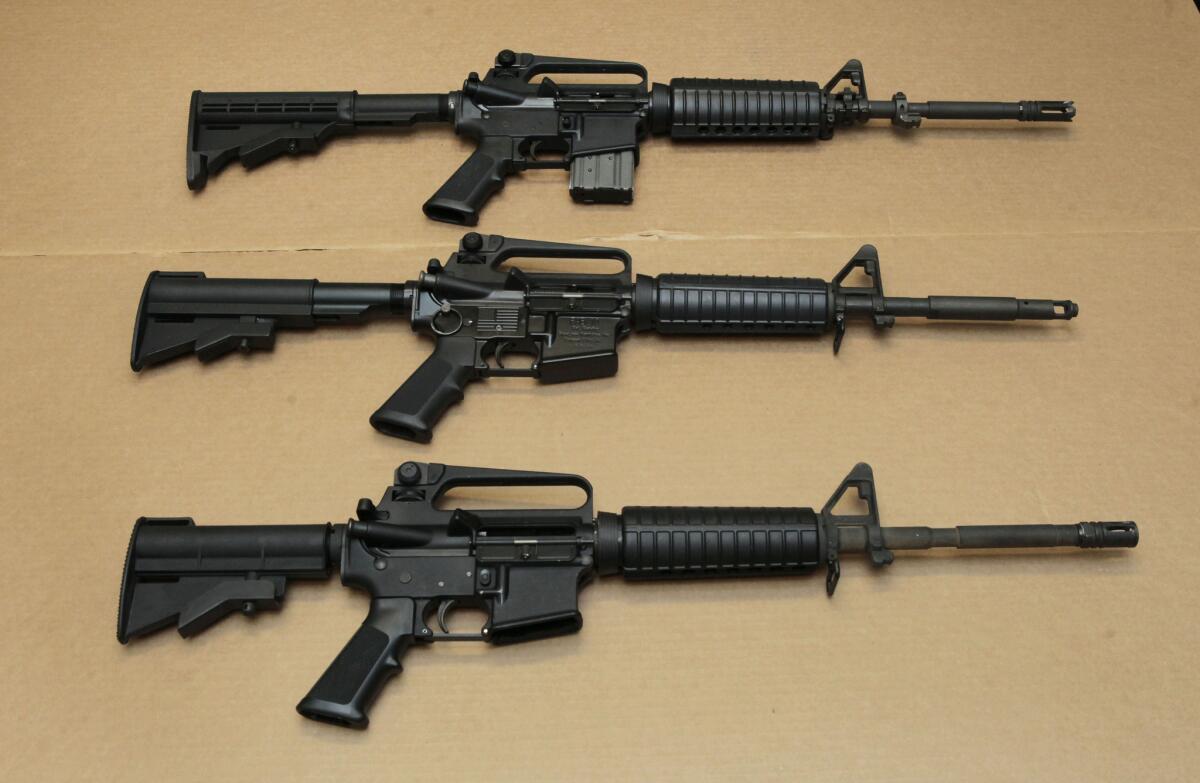The AR-15-style rifle: a popular seller tainted by mass murder

The military-style rifles used in some of the deadliest mass shootings in U.S. history, including Sunday’s massacre at a gay nightclub in Florida, have become increasingly popular in recent years among American consumers.
The Colt AR-15 and similar models of semiautomatic rifles, which fire as fast as the shooter can pull the trigger, are a consistent source of profit for arms manufacturers, who have reported strong sales growth even as sales for other types of firearms have slumped or remained flat.
But the weapons can be a financial liability too. In the wake of deadly shootings, several major investors for public employees, including funds that manage California teacher pensions and the University of California’s endowment, have distanced themselves financially from the makers of those rifles.
Nearly every major arms company builds a version of the AR-15, which is a lightweight, portable rifle that can fire accurately at long ranges. The rifle has very little recoil, meaning it doesn’t kick after each shot, which allows for greater accuracy.
“It stays on target, it’s very accurate, and it’s devastatingly lethal,” said Jay Wachtel, a retired Bureau of Alcohol, Tobacco and Firearms agent and a lecturer at Cal State Fullerton. “You don’t have to have an accurate hit in order to kill someone.”
A federal law enforcement source said the .223-caliber rifle used by 29-year-old Omar Mateen in the Orlando, Fla., massacre was an AR-15 variant made by Sig Sauer, a subsidiary of a German company. On its website, Sig Sauer says its AR-15-style rifles are “gaining a reputation for revolutionary design, exceptional accuracy, engineered reliability and traditional craftsmanship.”
Semiautomatic rifles fire one bullet each time the trigger is pulled. With parts that can be purchased legally, some rifles can be converted to automatic weapons, meaning holding down on the trigger releases a continuous stream of bullets. Still, from a well-trained shooter, experts say, semiautomatic fire can be more deadly than automatic fire, which is harder to control.
You don’t have to have an accurate hit in order to kill someone.
— Jay Wachtel, retired ATF agent and lecturer at Cal State Fullerton
The police have not said whether the rifle used in the Orlando attack had been modified. AR-15-style rifles, which typically sell for more than $1,200, can be purchased legally in most states.
Some states, including California, limit the capacity of magazines that can be used with such rifles. Florida does not.
The A in AR-15 stands for Armalite, the company that created its forefather, the M-16, in the late 1950s and sold the design to Colt. The M-16 was used by the U.S. Army during the Vietnam War.
Colt modified the design and released it to the civilian market in the 1960s as the AR-15.
“When you’re into cars, you want the fastest and the sleekest,” Wachtel said. “If you’re into firearms, you want the most lethal. It had the aura of the military, so it became extremely popular.”
During a 10-year federal ban on some assault-style weapons, manufacturers were forced to modify their designs in a way that made the guns less attractive to some consumers. Sales slumped. When the ban expired in 2004, gun makers increased production of semiautomatic rifles.
“It’s hard to keep making money if you only make basic hunting rifles, because people buy one or two and use them for a long time,” said Daniel Webster, director of the John Hopkins Center for Gun Policy and Research. “But these companies know their market. They know that gun guys like macho weapons, and that they’ll buy new products they don’t necessarily need.”
These guns, dubbed “modern sporting rifles” by manufacturers, have been big sellers over the last few years. Between 2010 and 2014, sales grew at an annual rate of 28%, double the rate for all other types of firearms, according to the gun conglomerate Remington Outdoor, citing figures from the National Shooting Sports Foundation.
Although Remington Outdoor reported a $46-million drop in firearm sales overall last year, sales of its AR-15 style rifles were up more than $12 million.
In 2014, the most recent year for which federal data is available, Remington said it made about 930,000 rifles, or about 28% of the 3.4 million rifles manufactured domestically that year. It’s unclear how many of those rifles were assault-style, because gun companies do not typically separate manufacturing figures from the broader rifle category in public reports.
Analysts at the brokerage and investment bank BB&T Capital Markets said in a report Monday that the Orlando rampage will probably lead to a spike in gun sales. Presumptive Democratic presidential nominee Hilary Clinton said in an interview with CBS on Monday that she wanted to restore the federal assault weapons ban, a move that analysts predicted would prompt a rush to gun stores.
After Adam Lanza stormed into Sandy Hook Elementary in Newtown, Conn., and killed 20 children with an AR-15-style rifle, one of California’s major public pension funds said it would divest from companies that manufactured assault-style weapons.
The California State Teachers’ Retirement System quickly sold stock in arms makers Smith & Wesson and Sturm Ruger, but getting out of another gun investment with a direct tie to Sandy Hook proved trickier: $500 million in a private equity fund managed by a New York company called Cerberus Capital Management.
The $7.5-billion fund owned shares of Freedom Group, a conglomerate of gun manufacturers that included the company that produced Lanza’s rifle.
Pension systems can easily sell stock in publicly traded companies. But it’s more complicated to get out of a private equity investment. Investors typically agree to let a firm manage their money for a decade.
“You don’t have any right to force the [private equity firm] to sell the entire position or sell your interest,” said Timothy Spangler, a UCLA law professor who has worked with private equity firms.
Days after the Newtown shooting, Cerberus announced it would sell the shares of the gun conglomerate, which has since become Remington Outdoor. But two years later, it had not found a buyer.
Cerberus told the teacher’s retirement fund and other investors that it would essentially buy them out of their shares if they wanted to divest from gun manufacturing. Sources familiar with that deal said the majority of fund participants took the firm up on its offer.
The University of California also was an investor in that fund, but sold its entire stake to another investor more than two years ago, UC spokeswoman Dianna Klein said. The university system also has sold stakes it held in Smith & Wesson and in a firearms distributor owned through a separate private equity investment.
Not all investors cashed out of Remington when Cerberus offered. The San Francisco Employees’ Retirement System invested $20 million in the fund in 2006. Spokesman Norm Nickens said that the pension fund did not request that Cerberus buy it out and that it still has a financial interest in Remington.
Nelson and Koren reported from Los Angeles. Times staff writer Del Quentin Wilbur contributed to this report.
ALSO
After Orlando, California lawmakers push for action on gun control
How Trump’s and Clinton’s claims in their speeches after the Orlando shooting stack up
Orlando gunman had used gay dating app and visited LGBT nightclub on other occasions, witnesses say
More to Read
Sign up for Essential California
The most important California stories and recommendations in your inbox every morning.
You may occasionally receive promotional content from the Los Angeles Times.












